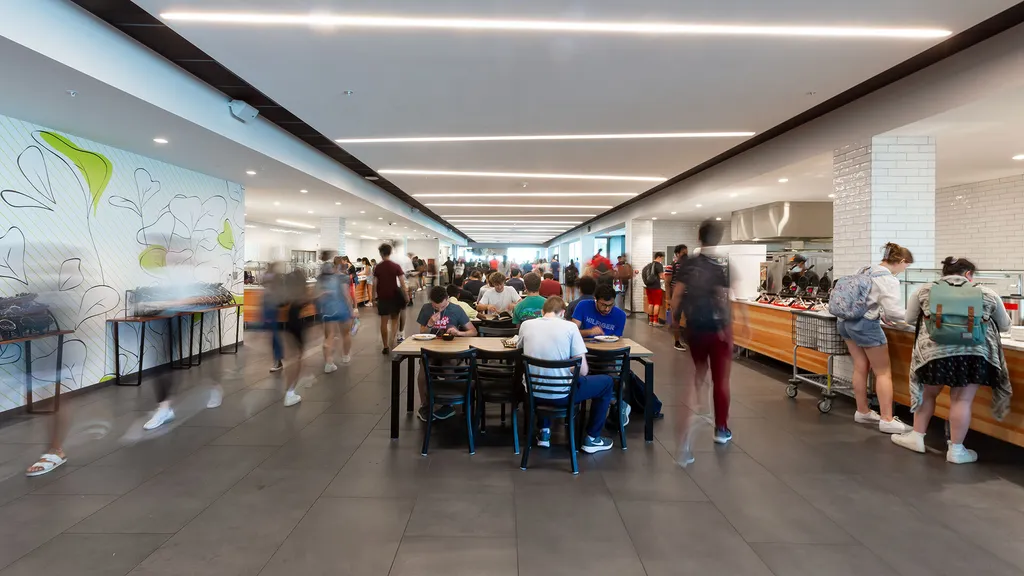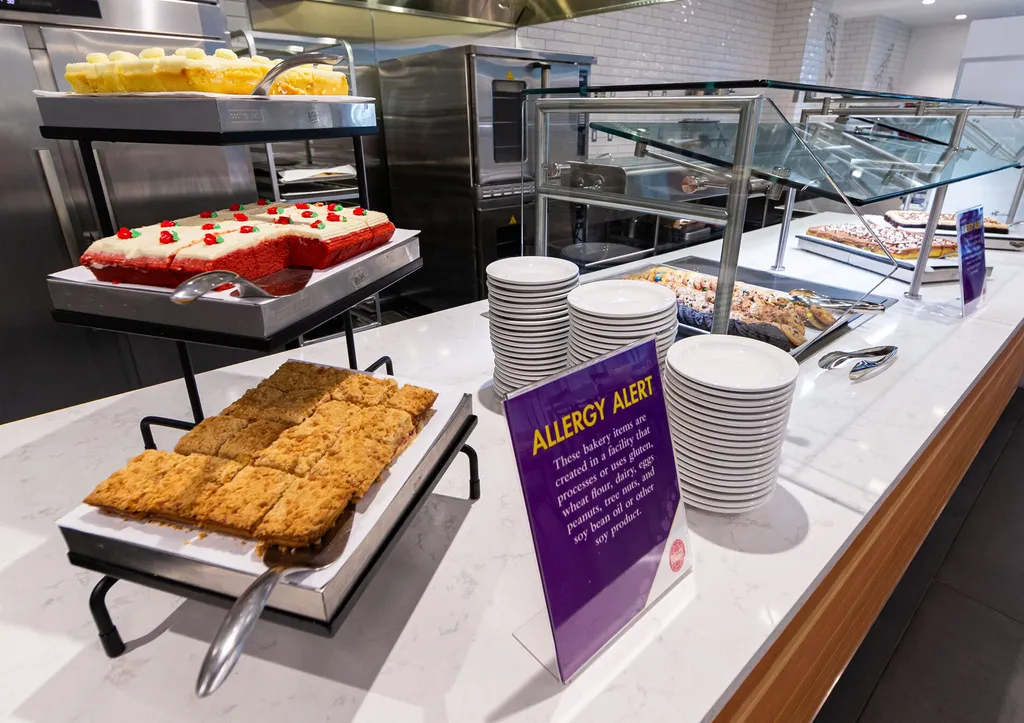- October 13, 2023
- By Karen Shih ’09
Are you delighted by the dal at Yahentamitsi, smitten by sizzling stir-fry at South Campus Dining Hall or hankering for hand-cut fries at 251 North?
You can thank the “best culinary staff” Senior Executive Chef John Gray has ever worked with at UMD’s Dining Services—a team that’s taken him 14 years to put together.
“When I first got here, everything came out of a box in the freezer,” he said, laughing. That meant his employees had a steep learning curve. Rather than just heating dishes in the oven, they had to be taught how to cook them. “I’d have to stand there and physically make things with them. But now, we can throw them a recipe and they’ll say, ‘I got it.’”
Gray oversees 1,500 employees, including cooks, bakers and clerks, across the three dining halls and catering services. They’re excited to debut new recipes this year, drawing from their own cultural backgrounds as well as popular food trends. Executive Chef Mike Norman runs the team at Yahentamitsi, UMD’s newest dining hall that opened in Fall 2022, and across campus, they serve about 25,000 meals per day.
Both have strong professional pedigrees. Gray, a graduate of the Culinary Institute of America, came to UMD from high-end hotels and casinos. Norman, a graduate of the Pennsylvania Culinary Institute, cooked for Congress and at embassies before arriving at UMD in 2019.
“Being here as given me the freedom to create and test all kinds of different foods,” said Gray. “We can take a station, make a decision, and throw it out there to students and see what sticks, because they’re open-minded.”
Gray and Norman explain how the pandemic paved the way for authentic pakoras and curries; what they learn from empty (or not so empty) plates at the dish return stations; and how they make sure students with allergens can stay safe while trying new dishes.
Gray: Until we started Yahentamitisi, most of the menus were written by me, with some input from the chefs. These days, anybody on the team can throw ideas out. I walk through the three dining rooms at least twice a day, and they’ll catch me and talk about it. Then we have to discuss what station it could be served at, what products we need and we work through that process.
Norman: One of the first guys we hired after many longtime staff transitioned out during COVID was Edbin Gomes. He’s been a curry chef for, like, 50 years. Initially, he was just one of my cooks, learning the menus, worked really well, got a lot of respect in the kitchen. Then, when we were setting up Yahentamitsi, he was so vocal. He brought out his book of recipes. My No. 2, Tally Rao, the production manager, she’s from India as well, so she’s overseeing it. Now, Edbin has brought other Indian American cooks to work here as well. They’re creating the most authentic Indian food you’re going to find—we even have guys making pakoras from scratch, frying them here.
I had a student come up to me and say, “This dal is just like my mom makes it at home.” We’re doing something that makes someone feel more at home. Every dish we do has the opportunity to touch a student in that way.

Gray: I always tell our cooks, if you see something we’re doing and we can do it better, don’t hesitate to tell us. We have people from Guatemala, El Salvador, Dominican Republic. Show us, and if it looks great and tastes great—and it normally does—we’ll change the recipe in our system.
Norman: It’s great to share your food with the students. I’m from Louisiana, so my thing is gumbo. I was taught when I was 5 years old in my grandmother’s kitchen. Now, I do four or five variations for a gumbo bar we serve every year at Mardi Gras.
Gray: We get most of our ingredients from US Foods, but we also work with other brokers to get specific grains or broths or spices we can’t get from them, like for our pho and ramen bar.
Norman: Chef will also get in his car and go to the most authentic Asian or African markets to get ingredients. Between D.C. and Baltimore, we’re in a really diverse area.
Students come to us with ideas too. They’ll catch me in person and
say, “I saw this on TikTok!” They told me there was a thing called a
“grinder” that goes on an Italian sandwich. And we had the ingredients:
lettuce mixed with mayonnaise and banana peppers and vinegar, and it
becomes this slaw that goes over the top. The kids loved it. So now we
do it on the grill station once a week. Another kid brought us the
TikTok pasta recipe, with the feta and cherry tomatoes, and we tried
that too.
Gray: For each new recipe, we have to think: Which station can we do it on? Are we cooking it to order, or is it going to be prepared and set out? Do we do half in the back kitchen, and half out front? We’ll have a quick meeting with the cooks that are going to produce it, give them a recipe, show them some photos, then go for it and see how students like it.
Norman: We figure out servings based on existing student engagement. If we usually run burgers on a Monday, and we do 2,000 per meal period, then we would double that for a special like the Wye Angus burger, made from 20 or so full steers we get from a UMD farm each year (we save the prime cuts and briskets for Harvest Fest or Christmas meals). Nine times out of 10, we’re within 10 to 15% of the forecast.
[A New Recipe for Success: How UMD Student Dining Has Changed Over the Decades]
Gray: Our student body is really reactive. They’ll let us know through the QR codes on the tables what they do and don’t like. We get those comments in real time. And one piece everybody forgets: We look at what waste comes back on the dishes. We’re always looking at what’s left on the plates.
If it does well, we try it again the next month. And the next month. And if it looks like something students really like and they’ll eat it at least once or twice a week, then we look for a spot in our permanent rotation. New items can do really well and then level off, so we have to look at, is it sustainable? Or has it hit rock bottom? Maybe it becomes a once-a-semester special. We need to make sure students are hitting every station almost equally, so we can balance out staffing.
Norman: Sometimes new dishes can be too successful. We had the Ahi tuna nachos in the spring, and it was a big hit. It was too small of a station, there were too many people waiting in line and then we ran out, so the next time, we had to try a different station.

Gray: Tracking allergens and nutrition is a huge part of our work. When we’re writing recipes and sourcing ingredients, we make sure we’re following rules that are part of our standards. For example, there’s no nuts of any kind at any of the hot food stations. If a stir-fry dish has cashews or peanuts, we’ll do it without that. Every station has icon cards that tell students about top allergens, as well as dairy or gluten.
We have this system called Food Pro, where we put all of our recipes, order all of our food and do inventory. Every new item we get, we put into that system with all of the ingredients from the box. Our nutritionist, Sister Maureen Schrimpe, and her student workers can look at it and input nutrition information.
When we put food out at a station, we check it again to make sure we didn’t have to use a substitute product or tweak the recipe before it went out.
Norman: We want to make sure students are safe. We check every item like it’s the first time, every time.
This is part of a monthly series that looks behind the scenes at “what it takes” to keep the University of Maryland humming and create a vibrant campus experience. Got an idea for a future installment? Email kshih@umd.edu.
Topics
Campus & CommunityUnits
Dining Services